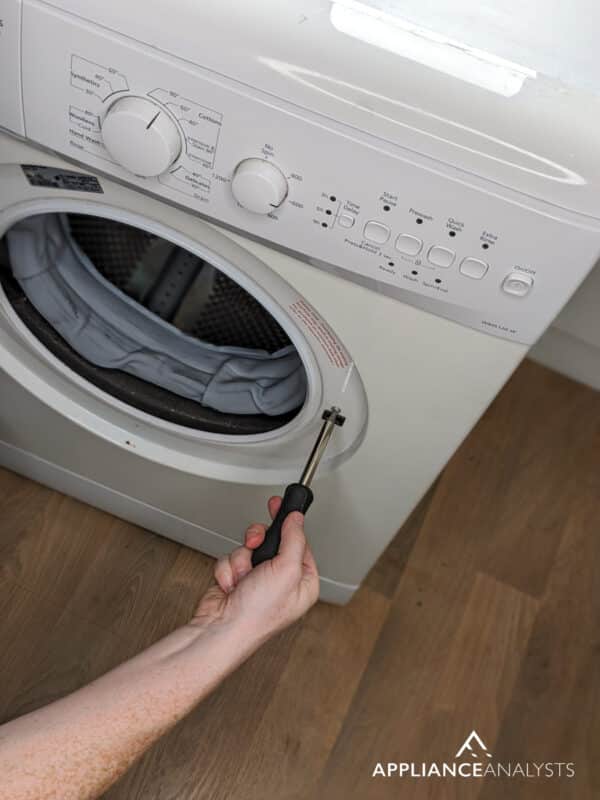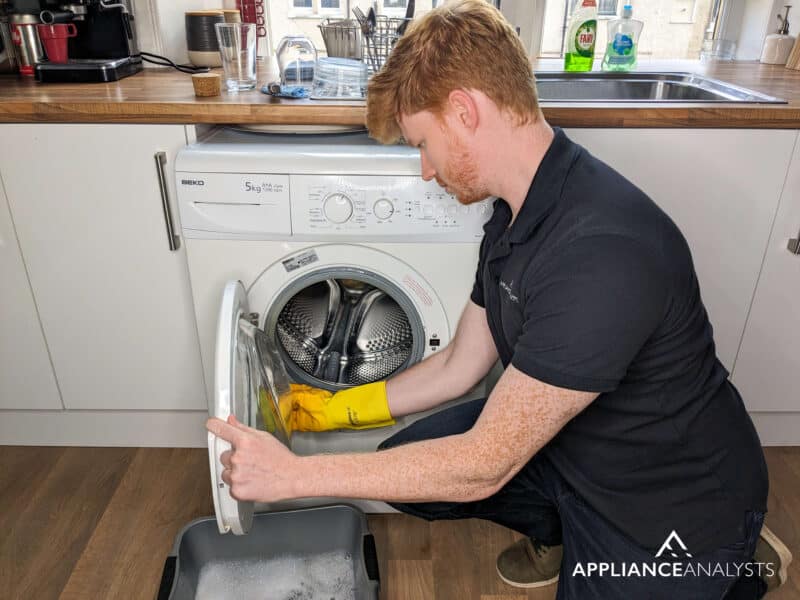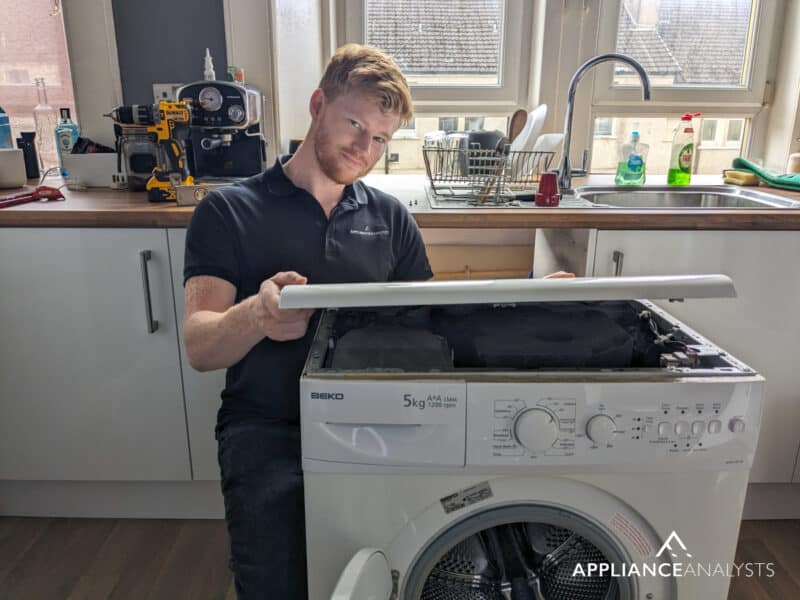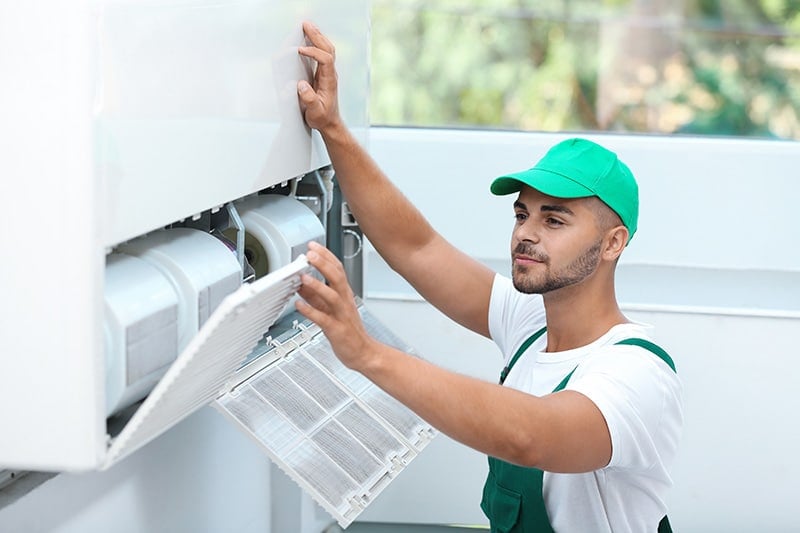We've independently reviewed this article to make sure it's as accurate as we can make it.
To find out more about our article creation and review process, check out our editorial guidelines.
Are you having trouble trying to fix your washer’s door lock?
That sucks! Washers are a key part of our daily lives, so ensuring they work as best as possible to do our laundry is very important.
I know how annoying it can be to have your washer fail and put you in a position where you have to spend time fixing door lock problems – especially during a busy day.
But don’t worry; you’ve come to the right place for answers. Below, you’ll find a list including 7 common reasons why you’re having issues and some simple ways to address each one.
When you’re stuck fixing door lock problems in your modern washer, consider door lock failure, door strike damage, debris or obstruction on the lock, or a bent lid. The door lock problems can also be due to door misalignment and several other reasons.
Read on to stop your washer door lock problems once and for all!
Why You’re Having Washer Door Lock Problems
The type of washer you have can have a great effect on why there are door lock problems and how the door lock works. There are 2 main types of washers: front load and top load models. In my experience, each model has its own way of working, doing your laundry and using their door locking mechanism.
Front load models, for example, can lock and unlock several times during a cycle. As long as the washing cycles are completed normally, there’s nothing to worry about. But if you notice strange things, such as a repetitive clicking sound, it typically indicates a door lock issue.
In such cases, here are some things that can be to blame.
Top Load Washers
Top load washers have unique components that front load models don’t, such as an impeller and an agitator. Such differences are normally not too noticeable, but when it comes to addressing a specific door lock issue, the elements to consider do vary.
#1 Door Lock Failure
The first possible reason why you’re stuck fixing door lock problems in your modern washer is that the lock itself is either damaged, not communicating with other components of the washer properly, or is simply defective.
Solution: The simplest solution in this situation is to replace the door lock. From what I’ve seen, the door lock replacement process is normally inexpensive, quick, and moderately easy.
The specific steps to replace your top load washer’s door lock can vary depending on the brand and model you own; please read your User Manual to find the right instructions and part model number. If you no longer have your User Manual, don’t worry; you can also refer to our free resource below to find it.
#2 Door Strike Damage
The next potential culprit when you’re trying to fix door lock problems in your modern washer is that the door strike is damaged.
The door strike is what the door lock latches on to in order to stay locked. When the strike works normally and is undamaged, your washer will lock its door without any issues. But when the strike is broken or loose, the locking process is affected, resulting in your current situation.

Solution: When the door strike is broken, my usual advice is to replace it entirely, as any attempt to repair it will bring diminishing returns.
As with the door lock, you’ll have to check your User Manual to determine the right steps to properly access and replace the door strike. Once you have a clear view and access to the door strike, please inspect it for breaks and use online images of the part for reference and comparison.
Replacing a modern washer’s door strike is normally inexpensive and simple.
#3 Debris or Obstruction
Over the years, I’ve found that debris or any other kind of obstruction can also get in the way and prevent modern washers from locking properly.
Depending on how well you maintain your appliance and how often you clean it all around, there might be gunk or even caked-on detergent residue preventing its door lock from latching properly onto the door strike.
Solution: When I see a washer that has not been cleaned in a long time, the first thing I recommend is to take the time to clean every component related to the door locking mechanism.
You can use a damp cloth to remove any gunk or caked-on detergent residue, and if you’re feeling especially productive, you can prepare a mixture of equal parts water and vinegar to clean the appliance and disinfect it fully.

Once you’re done cleaning the door locking mechanism, try closing the door again, run a cycle, and see how it goes. If obstruction was the problem, everything should now be back to normal!
Tip: Coins, clips, and any other object you forget in your pockets can also get trapped inside the locking mechanism and other parts of your washer, so please remember to always check your clothes before placing them in the drum.
#4 A Warped or Bent Lid
A warped or bent lid can also explain why you’re stuck fixing door lock problems in your modern washer. Top load washers are prone to having their lids bent, as it’s simple to forget that we shouldn’t place heavy objects on them.
Avoid putting your dirty laundry hamper or heavy detergent containers on your washer’s lid at all times.

Solution: I’ve found that the simplest way to test whether a door lock problem is present due to warping or bending is to push down on the lid and see if it locks. If so, you have a clear answer to what the problem is.
Depending on what you want to do, you can either try to readjust the lid to fit properly or replace it altogether.
Note: If you recently moved and had your washer transported by a professional company, the movers might have warped the lid accidentally during the process. Always ensure that your furniture and appliances are in good condition immediately after having them delivered to your new home.
Front Load Washers
Having covered the main issues that can arise with the door lock on top load washers, let’s now move on to the obstacles you can encounter when you own a front load model.
Although locking mechanisms in washers aren’t too complex, they can vary from appliance to appliance, which is why I want to cover a couple more things you should look out for.
#5 Immediate Locking
If your front load washer locks immediately after you’ve finished loading it up and closing the door, there’s a good chance there’s nothing wrong with it.
Front-load washers typically lock right away before tumbling or filling with water to prevent leaks and other issues, which can sometimes trick people into thinking the door lock mechanism is faulty.
Solution: Look carefully at how your washer behaves. If you hear a single locking sound and the cycle runs normally, there’s nothing to worry about.
However, if you hear repetitive clicking of the door lock and notice the cycle is not starting or the washer isn’t filling with water, you’ll need to look closer at the problem.
#6 Repetitive Clicking
Repetitive clicking is another possible reason you’re currently stuck fixing door lock problems in your modern washer. As I mentioned earlier, whenever you lock your washer door, you should only hear a single click, not several.
I’ve found that repetitive clicking typically means that your washer is continuously trying to lock its door, yet it keeps failing.
Solution: In cases where there’s repetitive clicking, the best course of action is to replace the door lock. You can, of course, access the part and check it to see whether there’s something blocking the mechanism or preventing it from locking.
However, more often than not, buying a new lock will be the most cost-effective, time-saving strategy.
#7 Door Misalignment
Lastly, let’s consider door misalignment as one more potential reason why you’re stuck fixing door lock problems in your modern washer.
Front-load washers use hinges in their doors to open and close whenever you add loads of laundry. Although hinges rarely misalign, it’s been known to happen occasionally, preventing the door lock mechanism from latching onto the door strike correctly.
A telltale sign that your washer’s hinges are misaligned is that you need to push the door shut with some force to lock correctly.
Solution: As with a warped or bent washer lid, you can either try to readjust the hinges back to normal or replace the entire appliance door if the damage is too extensive.
If, at any point during the process, you feel unsafe or unsure of how to do the next step, please contact a professional for help.
Uncommon Causes for Door Lock Issues
If you’ve already tried all the solutions above and are still struggling to fix door lock problems with your modern washer, you should consider a Control Board failure.
There’s a chance that your door-locking mechanism and everything related to it is okay, yet your washer’s brain (the Control Board) isn’t. If the Control Board is failing, the door lock will not engage due to miscommunication between it and the rest of the appliance.
In such cases, you’ll have to consider your options carefully, as replacing a washer’s Control Board is expensive, sometimes even as expensive as buying a brand-new washer.
Good Practices to Prevent Washer Door Lock Problems
To prevent washer door lock problems in the future, I’d like to share with you a couple of good habits that I recommend you implement into your daily routine.
- Understand your washer’s cycles: Knowing how your washer behaves during a cycle can help save you a lot of time. On many occasions, normal door lock behavior during a cycle can be easily mistaken for failure if you’re unfamiliar with how your appliance runs.
- Do regular checkups: Ensuring your washer is always clean, well-maintained, and not making any strange noises that can indicate an issue is key. The more attention you pay to your washer, the more efficiently it will run and the longer it will last.
Fixing Your Washer Door Lock
That about covers it!
When you’re stuck fixing washer door lock problems, something as simple as doing laundry can be frustrating and time-consuming.
Luckily, as I hope this piece has helped you better understand, addressing the most common causes behind washer door lock problems is easy and quick. More often than not, simple actions, like ensuring the door strike is unobstructed and the lid isn’t warped, can go a long way.
Thanks for reading. If this article was useful and answered your most burning questions, please check out our other resources and free guides below and consider subscribing to our newsletter.
Have a great day!
-Craig.









